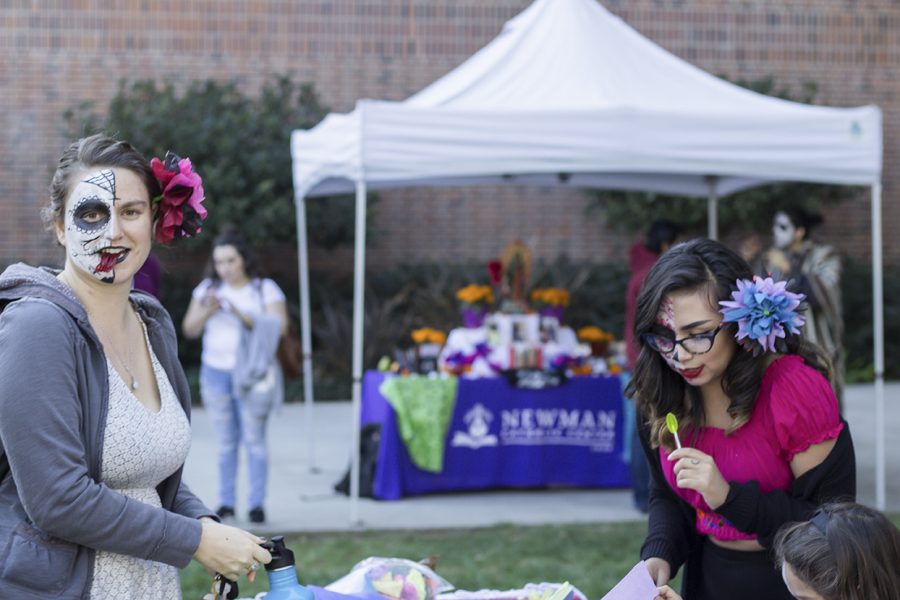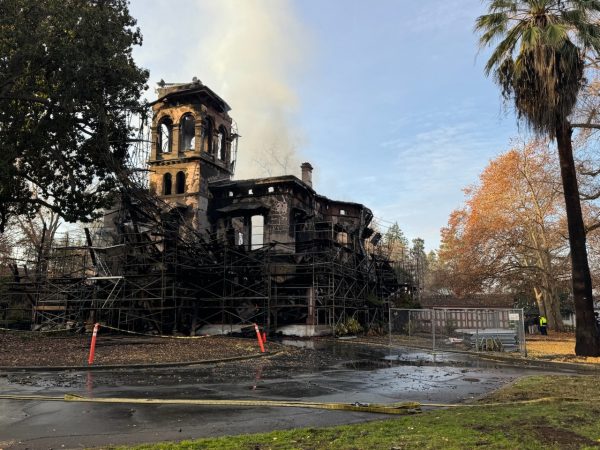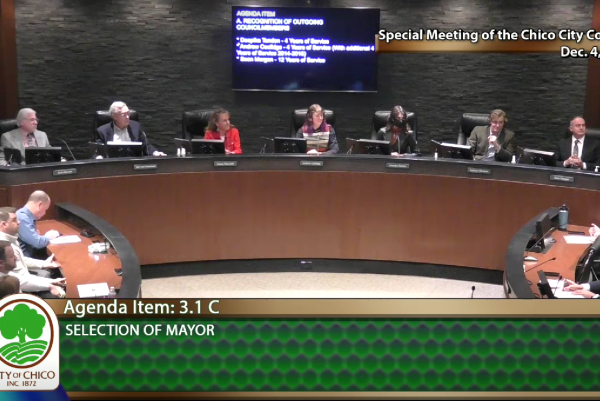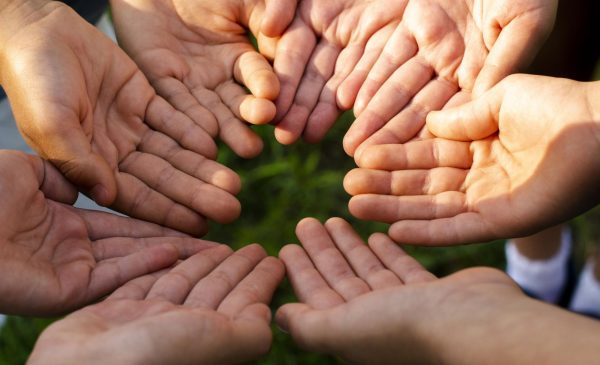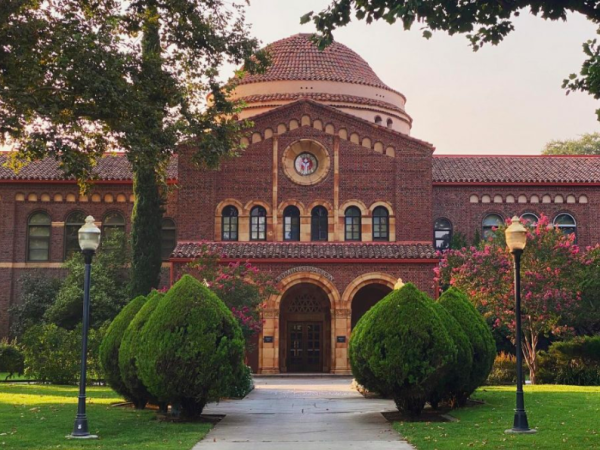Dia de los Muertos educates Chico community
Junior communication major Amy Rodrigues (left), enjoys a Twizzlers at the outside portion of the event. A friend involved invited her to get her face painted while she was attending the event. Senior Jessica Godinez (Right) helps a young attendee with some arts and crafts at the second day of the event. As a transfer student from the Bay Area, Godinez didn’t see much diversity when she first came to Chico. She was in culture shock and found Mecha. She loved what they stand for: social activism and bringing students together. Photo credit: Jordan Rodrigues
If Jim Pedraza died tomorrow he would want tamales de dulce or sweet tamales on his altar. Specifically, the kind his mom would make. But the most important thing to him is that he does not want to be forgotten.
Chico State celebrated All Saints Day, or Dia de los Muertos. Festivities lasted from Nov. 1 through Nov. 2, hosted by Latino-based fraternity Nu Alpha Kappa and MEChA de Chico State.
On All Saints Day, families gather to remember children who have died, and on All Souls’ day, the adults are then remembered. It’s believed that those two days spirits of deceased loved ones are allowed to reunite with their families.
Pedraza, a junior business major, said this was the 16th anniversary of the celebration hosted by NAK. More than 15 local and on-campus organizations came together to create colorful altars lining the walls of the auditorium and the grounds of Trinity Commons, he said.
The event is celebrated with colorful altars decorated with photos of deceased family members, sugar skulls, candles with saints painted on them, marigolds and ofrendas, offerings of favorite foods and things their family members used to love.
Each altar is made with the hope that their deceased family member will journey to be with them. No alters were alike. A six-piece mariachi was in attendance and moved from altar to altar, serenading souls of those voyaging to the physical world with traditional songs such as Vicente Fernandez’ classic “Volver, Volver.”
Dia de los Muertos is a two-day event deeply rooted in the indigenous culture of the Aztecs with influence from Catholic, Spaniard conquistadores. It started as a celebration from the Aztecs, Pedraza said. The Spanish conquistadors brought Catholicism to Latin America and combined the celebration with their traditions of All Saints’ and All Souls’ Day.
Norma Fabian, a junior sociology major and member of Latinas in Action, said growing up, she would make altars with her mother every year. She said that her mother believes that when loved ones came back from the dead, they enjoyed the stuff they used to love with the gifts on the altars.
“I don’t know if it’s true, but she used to put flour on the floor, so we would know that they came because we would see their footprints,” Fabian said.
Figures of tamales, fruit, saint candles, orange flowers, a beer bottle and photos of loved ones, including Tejano star Selena were placed on the Latina’s in Action altar.
“The whole purpose of day of the dead is a celebration of life,” said Juliana Morales, a senior and liberal arts major. “The spirits of the deceased are out and about walking amongst the living and so what we do is with candles, we guide them to our altar.”
Morales says that with celebratory face painting, a full painted face and specific clothing means the person is representing someone who moved on. If only half of their face painted, it represents the two faces of the living and the dead.
Christopher Diaz, a junior criminal justice major and NAK member, said many community members from local schools such as Rosedale Elementary, Chico High School and Spanish teachers from Chico State brought their students to learn more about the cultural significance.
“Chico state is not highly diverse, it’s predominantly caucasian and to have any cultural event, in general, is pretty significant because it shows that the people who are embedded here have roots,” he said.
Diaz says his mom migrated from Mexico and he was never disinterested in the event, he was just never taught about it in school.
“I think that is something that is flawed,” Diaz said. “We only learn things in our textbook, but we don’t get to learn our own culture.”
Students from other cultures on campus also joined in on the celebration to show the connections between their cultures and the Latinx culture.
Koua Thao, a senior kinesiology major and the member of Eta Mu Theta fraternity, said their group has deep roots in the Hmong culture. They were invited by NAK to present an altar with significance from their cultural background.
“When we do have any deceased family members we spend a whole week building houses with paper money in the shapes of boats,” he said. “It’s a way to guide your deceased family member to the next journey of their life.”
Their altar was a combination of Christianity and shamanism which are practiced within the Hmong culture and also by his fraternity brothers.
Along with embracing different cultures, Dia de los Muertos provided a sense of Latinx community on campus.
“Now you see a lot more minorities, but my first semester about three years ago there were hardly any,” Pedraza said. “I was living in Whitney Hall and I was the only minority in the whole building, well there were about three or four of us. I felt so homesick, sad and depressed. Dia de los Muertos was actually the first event where I saw a whole bunch of Latinos come together.”
Pedraza said he’s passionate about the event as a co-runner because the Dia de los Muertos event held three years ago was the first time he felt integrated on campus when he first arrived.
“It was the first time in Chico that I felt like I belonged somewhere,” he said. “It made me feel at home.”
A lot of people misinterpret the celebration as a “Mexican Halloween” Pedraza said, and the point of the event is to educate the Chico community.
“We want to educate people that it’s not a Mexican Halloween,” Pedraza said. “It’s not ok to be dressing up with pieces from our culture.”
If Jim Pedraza were to die tomorrow, he said he does not want to be forgotten, but for the event he wanted participants and community members to remember the reasons why they were coming together to celebrate.
“It’s a day we honor our past loved ones,” Pedraza said. “It’s the way we honor our ancestors and we don’t want to forget them, we want to honor them and that’s why we build these beautiful altars.”
[masterslider id=”18″]
Bianca Quilantan can be reached at [email protected] or @theorion_news on Twitter.



